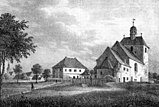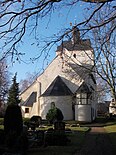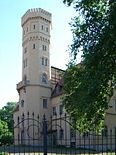Pomßen
|
Pomßen
Parthenstein parish
Coordinates: 51 ° 14 ′ 20 ″ N , 12 ° 36 ′ 46 ″ E
|
||
|---|---|---|
| Height : | 142 m above sea level NN | |
| Area : | 12.32 km² | |
| Residents : | 764 (March 31, 2016) | |
| Population density : | 62 inhabitants / km² | |
| Incorporation : | January 1, 1994 | |
| Postal code : | 04668 | |
| Area code : | 034293 | |
|
Location of Pomßen in Saxony |
||
Pomßen ( ˈpɔmzn̩ ) is a village located 20 kilometers southeast of Leipzig . It belongs to the Parthenstein community . The most important sight is the Romanesque fortified church of Pomßen , built in the 13th century, with the oldest playable organ in Saxony by Gottfried Richter from 1671.
history
The square village of Pomßen was probably founded by the Sorbs; at least the place name of Slavic origin indicates this. When the village was founded is unknown. The first written mention comes from the year 1255, when the knight Fridericus de Pomzin is mentioned in a document . The village of Pomssen had been written as early as 1391, although other spellings were still common until the 18th century.
Pomßen was one of the most important aristocratic seats in Saxony. Several hundred hectares of land belonged to the manor and in the 16th century there were around 40 hoof farmers . In 1439 Nikel von Pflugk received Pomßen from burgrave Georg von Leisnig as a fief. Members of the Pflugk family resided at the Pomßen moated castle until 1534. In 1529 the first Protestant church visit took place in the place, with which the new faith was introduced in the local parish.
In 1536 Hans von Ponickau acquired Pomßen. From then on, the Ponickau family owned the estate for almost two and a half centuries. As early as the 16th century, the Ponickaus had the moated castle converted into a castle, which was last built in the 19th century as a neoclassical building.
The fortified church of Pomßen from the 13th century was redesigned in Baroque style under the church patrons of Ponickau after the tower had partially collapsed in 1661. A gallery was drawn in on the north side and a two-storey patronage box was added to the choir , which is richly decorated with stucco towards the chancel . Since then, an arch has connected the main nave with the south aisle to form a hall with the figuratively decorated pulpit from the late 17th century attached to the pillars of the choir.
The last owners of the Pomßen estate since the end of the 19th century were the Princes of Schönburg-Waldenburg . The Schönburgs were expropriated in 1945 as part of the land reform.
During the Thirty Years War the village was sacked by the Swedes in 1642. During the Seven Years' War and at the time of the Battle of Nations in 1813 there was fighting over the place and the residents suffered from billeting. On October 20, 1943, Pomßen was bombed from the air, which led to the destruction of some houses.
In the past, Pomßen was a very large and populous village. Already in 1834 almost 600 people lived here, in 1939 the place had 900 inhabitants and in 1950 reached its highest population with 1145 people, which was due to the influx of many refugees and displaced persons. Since then, the population has steadily decreased. The last official survey of the independent municipality of Pomßen showed 688 inhabitants for 1990.
On January 1, 1994, the municipality of Parthenstein was rebuilt from the previously independent municipalities of Grethen, Großsteinberg, Klinga and Pomßen.
In 1999 the church council set up a trust foundation together with the German Foundation for Monument Protection , from the proceeds of which the urgently needed repair work could be carried out.
Fortified church in Pomßen around 1840
Child euthanasia
The Knauer case occurred in Pomßen in late 1938 or early 1939 . In the Knauer or Kressler family (both probably pseudonyms ) a blind son was born who was also missing his left forearm and his leg was deformed. The father sent a petition to Adolf Hitler asking for permission to grant the child a " mercy death ". Hitler had the case examined by his doctor Karl Brandt and agreed to the killing of the child around May or June 1939. In October 1939, Hitler signed a paper dating back to the beginning of World War II , authorizing the systematic murder of "terminally ill" people.
Development of the population
|
|
|
Infrastructure
The former primary school is used by associations. The children from Pomßen are now attending the primary school in Großsteinberg.
Varia
In the first part of the Austrian film trilogy Brothers , Pomßen is a setting.
literature
- Cornelius Gurlitt : Pomssen. In: Descriptive representation of the older architectural and art monuments of the Kingdom of Saxony. 20. Issue: Amtshauptmannschaft Grimma (2nd half) . CC Meinhold, Dresden 1898, p. 215.
- Klaus Günther: fortified church Pomßen. Beucha 1995. ISBN 3-930076-13-6
- Pombsen, or Pomsen . In: August Schumann : Complete State, Post and Newspaper Lexicon of Saxony. 8th volume. Schumann, Zwickau 1821, pp. 489-495.
Web links
- Pomßen in the Digital Historical Directory of Saxony
Individual evidence
- ↑ Numbers and facts on parthenstein.de , accessed on November 13, 2016.
- ↑ The Renaissance organ in the fortified church in Pomßen , accessed on January 4, 2015.
- ↑ Area changes from January 1, 1994 to December 31, 1994 on the website of the State Statistical Office of the Free State of Saxony , p. 7 (PDF; 64 kB), accessed on February 24, 2012
- ↑ Cf. Pomßen in the Digital Historical Directory of Saxony
- ↑ Numbers and facts on parthenstein.de , accessed on February 29, 2012.











